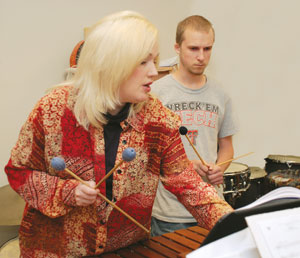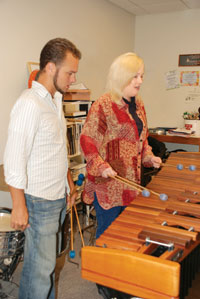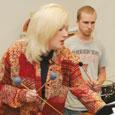 As a young clarinetist in Port Lavaca, Texas, Lisa Rogers never could have guessed that she would end up as president-elect of the Percussive Arts Society.
As a young clarinetist in Port Lavaca, Texas, Lisa Rogers never could have guessed that she would end up as president-elect of the Percussive Arts Society.
Encouraged by her parents to participate in various activities including dance, piano, and choir, she had never picked up a drumstick until the senior year of high school. Forced by an allergy to give up the clarinet, she became a beginning percussionist at the end of her high school career. Some of the difficulties she faced as an older beginner have contributed to her teaching. She is associate professor of percussion studies at Texas Tech University, where she has taught for 16 years. She is also a member of the Midland and Lubbock Symphonies and earned degrees from the University of Oklahoma, Southwest Texas State University, and Texas Tech University.
You started out playing clarinet but switched to percussion in your senior year of high school. How difficult was this transition?
I have always loved music and knew from the time I was 8 or 9 that I wanted to be a music teacher. My dad was a jazz saxophonist and started me on clarinet in 5th grade, the year before I could start taking band. I developed an allergy to reeds and ultimately had to give up the instrument altogether. My band director suggested trying percussion and because I had a background playing piano, I picked up the keyboard percussion skills very quickly. I know there are school districts today that will not let students become percussionists without some experience on piano.
In my journey the benefit of piano skills had less to do with reading music than with having the muscle memory necessary to play without looking down at my hands. I had no similar advantage on snare drum and had difficulty developing the chops. Other students had been playing snare drum for many years, and I could barely play a roll.
I remember well how this lack of experience became obvious during college auditions. I remember playing on mallets for instructors at one school. Then I was asked to play on snare drum; I remember one of the faculty members laughing at me as I played. This was devastating at the time, but I knew my skill was pretty horrible. I ended up attending the school anyway as a double major in piano and percussion.
There I met a wonderful teacher, Alan Shinn, who told me that if I wanted to make percussion my main instrument, I could do it. He said it would take 4 to 6 hours a day of practice to make up for my lack of experience. Because I was willing to work twice as long, I made huge improvements. Knowing that my teacher said I could make it as a percussionist was so inspirational to me. I knew he would stand by me, but there were still days when I thought I couldn’t make it.
What helped you improve the weaker areas of your playing?
I had to develop the discipline to practice for long periods of time on technical exercises that were mind-numbing at times. I spent many hours with the drum pad; it became my friend as I worked on certain patterns over and over. I used various books including Stick Control by George Lawrence Stone and also played etudes using a metronome. These sessions could be frustrating because I had strong musical knowledge but my hands could not respond to what my brain wanted. At times the sounds I produced were completely bizarre because I lacked consistency and stamina.
When you hear students playing now what is the most common weakness?
The biggest weakness is that we have so many percussion instruments to play at a proficient level. There is a temptation to specialize too quickly before students get a sense of the similarities between timpani and mallets or even four-mallet marimba and tambourine. I try to teach by emphasizing the common elements between the instruments. I ask many questions of students about how their bodies feel playing various instruments and what the best stance is for efficient playing with good tone production. We will even discuss the best body position for playing jingle bells and keeping these from jingling at the wrong time.
 How did you start directing steel bands?
How did you start directing steel bands?
I began working with a steel band while I was a graduate student at the University of Oklahoma. I was just a novice at the time and gained experience from working with a player from Trinidad who built instruments and also from attending workshops. The Oklahoma steel band was only open to young percussion majors, most of whom were in the top percussion ensemble. I didn’t understand this approach at first but discovered that steel band was great way to build the confidence of less experienced players. When we played a concert, the audience loved the music and often danced along with the performance. That joy transferred to the players, many of whom felt nervous. The confidence that came from steel band carried over to other percussion playing.
Some might question the educational value of steel band, and I thought about how this type of ensemble could benefit a student who will teach percussion at a middle school or high school. I realized that there are similarities to the development of mallet reading skills. The pans do not have a familiar basic keyboard setup and this forces students to develop good reading skills as they navigate notes in new locations. I can tell a huge difference when students go back to classical percussion instruments to sightread band music or a lesson etude. They are much quicker at learning the music thanks to the time spent in steel band.
My steel band has a small pan set-up much like a jazz combo. I have about five sets of pans, an electric bass player, drum set, and percussion. I do not use bass pans. The small set-up is because I wanted one player on a part to simulate the difficulties faced in band or orchestra. If a player drops the ball it is readily apparent.
We have also used our program to help some local schools start their own steel bands. At a local elementary school we helped begin an innovative program with steel drums, Orff instruments, and hand drumming. Some of my college students actually go out and teach the group. I work to provide varied performance opportunities for the Texas Tech steel band. The instruments are easier to move than many traditional percussion instruments. We have even played on cruise ships and I remind students that there are people who make their careers playing pan.
What other advice do you give students about developing a performing career?
Flexibility and a willingness to play many instruments can make you more marketable. If I had my way I would give four-mallet vibraphone concerts every week. It sounds great but I could not make a living that way. Thus, I pursue my passions but stay busy with many different gigs. I try be a good role model for my percussion students.
My college job is my main job but I am also principal timpanist in the Midland Symphony and principal percussionist in the Lubbock Symphony. It is important that students see that I am still active as a performer.
A harder lesson to teach is the importance of keeping a positive attitude and a good heart when you are playing percussion. You need to do everything possible to make the job you have successful. It might be playing drum set for a wedding anniversary on a night when you feel tired and grumpy. Giving the best effort possible will lead to future jobs. Showing up with a bad attitude will mean that others will get the call for gigs; there are plenty of other people waiting for a chance to perform.
You have worked with adult students at the International Music Camp. Is there any difference in how you teach beginning and intermediate adult players?
These players had many of the same difficulties as their younger counterparts. Sometimes I found the adults were not as fearless as 12-year-olds and did not want to do anything wrong. The physical problems were basically the same as with any beginners. Many of the adults saved up questions for me the entire year to ask during the summer camp sessions. The adults were definitely more conscious of having the right equipment than school students.
Many of the students at the International Music Camp were Canadian, and it was interesting to hear about the strong community band programs there. In this country most community bands provide an opportunity for former school musicians to continue playing as adults. Many of the older players I met had never participated in music in their younger days but decided to sign up for band. It was inspiring to work with them.
How did you get involved in the Percussive Arts Society and how does the organization benefit educators?
I found a home with them. My journey in percussion is very different from those who started playing in fifth grade. I had heard about the organization and subscribed to their magazine. I attended their convention in 1987 with the help of a Zildjian scholarship, and the experience changed my life. I met legendary players and teachers that I had only read about in books and magazines, and I shyly went up to some of them to introduce myself. There was not one person, regardless of how famous, who was not willing to help me. I realized that there were other ways to build up your knowledge in music besides college classes.
I became a member of PAS, went to conventions religiously, and while studying at the University of Oklahoma helped one of my professors with work he did on the association magazine. After he resigned I was asked to continue writing. The PAS offices were located nearby in Lawton, Oklahoma, which allowed me to stay active with the organization. I felt so strongly about what PAS provided, and this enthusiasm led to becoming a member of the board and now president-elect.
Sometimes I look back and wonder how a little girl from a tiny town in Texas went from playing clarinet to where I am today. At every step there were people who believed in my talent and encouraged me to keep striving. Because of their help, I am even more motivated to lend a hand to others on the journey.
.jpg) It’s All About the Basics
It’s All About the Basics
Just as a well-stocked kitchen is necessary for a chef to make a masterful dinner, keyboard percussionists needs a well-stocked arsenal of techniques to present memorable performances. For keyboard percussionists, time spent discovering and employing the basic elements of technique will improve accuracy and sound production. There are several basic ingredients two-mallet keyboard percussionists should keep on hand to improve performance skills. If two-mallet players emphasize these elements when performing, they should notice increased accuracy, consistent sound production, and efficiency of motion.
Ingredients:
Stance
Stroke
Body Position
Stickings
Grip
Serves: Keyboard percussionists at all levels.
Stance
Try keeping feet almost shoulder width apart in order to move easily and fluidly from side to side with the instrument for better accuracy and sound production. Avoid taking too many steps as you move throughout the range of the instrument. Too many steps tend to shift your center of gravity and compromise accuracy.
Body Position
If your instrument is height adjustable, adjust it in the same way you would adjust your snare stand. This will allow for maximum efficiency of body motion and, in turn, will help accuracy. If the instrument is not height adjustable, place blocks of wood underneath to raise the instrument slightly or build a wooden platform to stand on while playing if reaching the instrument is difficult.
If you are having trouble reading music, adjust the music stand. Don’t move your body closer to or further away from the instrument, resulting in poor or uneven sound production.
Grip
Two-mallet grip is similar to matched snare drum grip; however, try to fit the mallets almost in the groove of each palm or slightly offside. This placement will allow the mallets and wrists to move in up-and-down motions efficiently so the mallets contact the bars accurately.
Every pair of mallets has an ideal balance point (where the mallets will rebound the most). Even though the bars of a mallet instrument don’t rebound like the batter head of a snare drum, the balance of a mallet is extremely important for the efficiency of motion and accuracy. Test the rebound capabilities of your mallets on a drum pad or snare drum. Position your fulcrum (thumb and first finger grip) at various points along the mallet. Then, drop with a weighted wrist motion and check the number of rebounds. When you find the ideal balance point, you have also found where your fulcrum should be placed on the mallet.
Stroke
Try thinking about one stroke per wrist motion. As you strike a bar, follow through and return to the starting point in preparation for striking the next bar. Don’t strike the bar, stop, and lift again as preparation for the next stroke. This results in more effort with two motions and possible loss of accuracy.
Stickings
Fluidity of sound and accuracy on a keyboard instrument are also dependent on the stickings chosen by the performer. Most of the time, strict alternation of mallets provides a sense of flow and smoothness to the sound production. Accuracy is improved as well. However, there may be times when double stickings need to be employed to avoid leaps or crossing of mallets, which again should improve accuracy and sound production. Marking the stickings on a piece of music can be very valuable in enhancing motion memory and thus repeated accuracy.
The Musical Meal
Utilizing and understanding the basic ingredients and techniques needed for an impeccable meal or a superior performance will always prove successful to whoever is served. Whether an aspiring cook or master chef or beginning or ad-vanced keyboard percussionist, it’s all about the basics.





